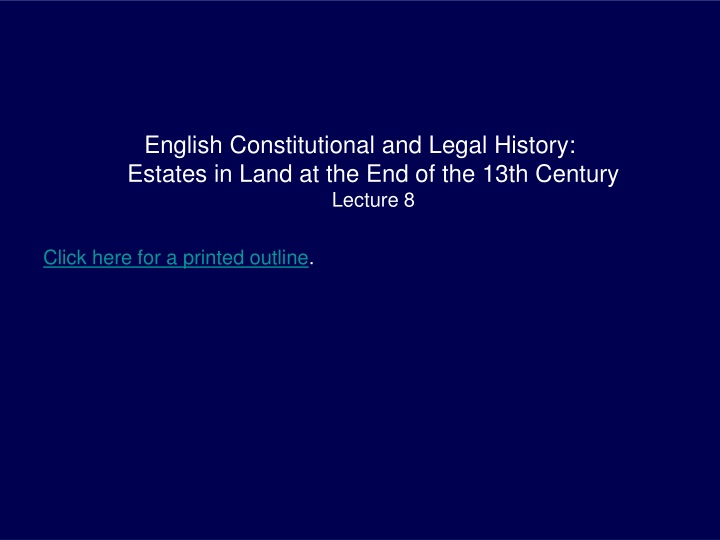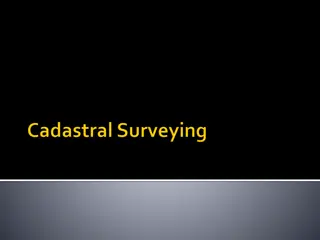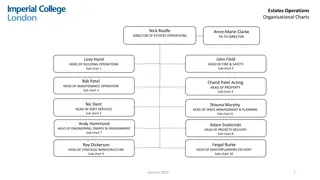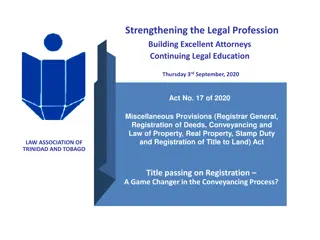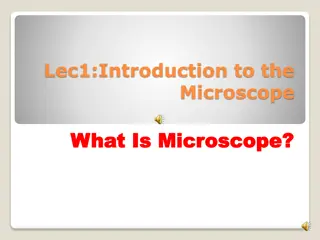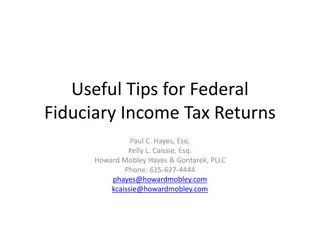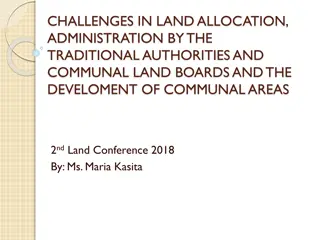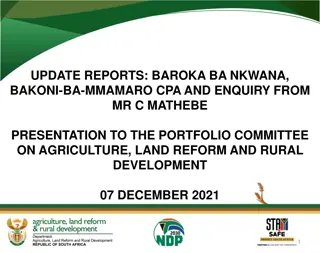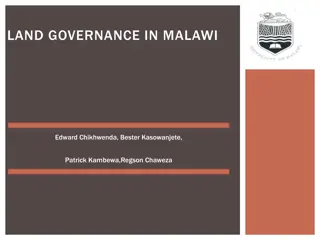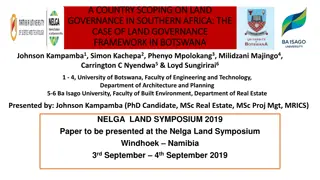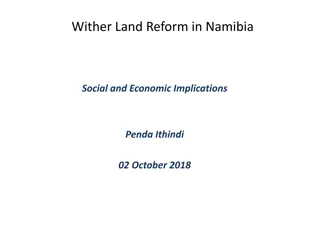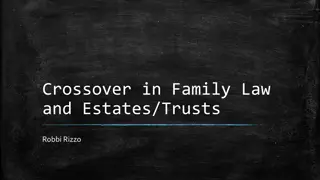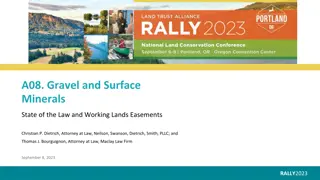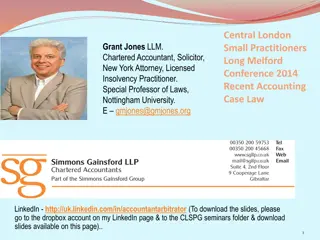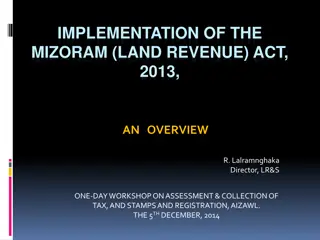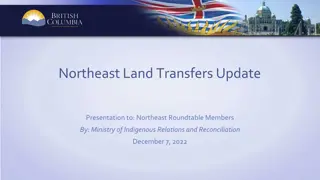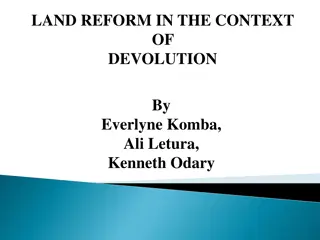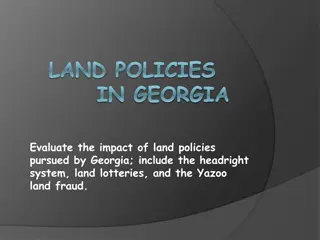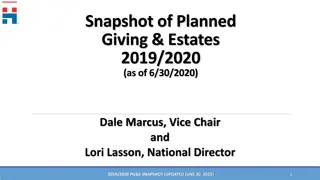Estates in Land at the End of the 13th Century
The lecture delves into the complexity of estates in land at the end of the 13th century, exploring the rise of fee simple, fee tail, dower, and curtesy as different types of land ownership. It discusses the interplay of property, family, and lordship during that era, highlighting key statutes and definitions that shaped the English legal system.
Download Presentation

Please find below an Image/Link to download the presentation.
The content on the website is provided AS IS for your information and personal use only. It may not be sold, licensed, or shared on other websites without obtaining consent from the author.If you encounter any issues during the download, it is possible that the publisher has removed the file from their server.
You are allowed to download the files provided on this website for personal or commercial use, subject to the condition that they are used lawfully. All files are the property of their respective owners.
The content on the website is provided AS IS for your information and personal use only. It may not be sold, licensed, or shared on other websites without obtaining consent from the author.
E N D
Presentation Transcript
English Constitutional and Legal History: Estates in Land at the End of the 13th Century Lecture 8 Click here for a printed outline.
The topic of the lecture The story is one of great complexity the rise of the fee simple, the fee tail, dower, and curtesy different types of what a later age called estates in land. The first two can be traced to statutes of Edward I, the statute Quia emptores in 1290 and the statute De donis in 1285. Both are rightly seen as being connected with alienability, but even Maitland fundamentally misconceived what was going on. What was at stake in the 13th c. is the interplay of property, the family, and lordship. Lordship drops out of the picture as an important force in shaping the law of freeholds in the 14th c. for reasons that we will come in due course, but it is still important in the 13th c. though not nearly so important as it had been in the 12th.
Some 15th- century definitions G grants to A and his heirs creates a fee simple, the highest estate, freely alienable, not devisable, descendible generally, both to descendants of A, and to his collaterals. 8 G grants to A and the heirs of his body creates a fee tail. It may descend only to A s issue (descendants). It is freely alienable but the alienee takes subject to the interest in the heirs of A s body. G grants to A for life creates a life estate. It may be alienable, but the grantee s interest is limited by A s life. Dower is a life estate in the widow in 1/3 of all lands of which her husband was seised at any time during the marriage in fee simple or fee tail, which land the heir of the marriage, had there been any, could have inherited Curtesy is a life estate in the widower in all of the lands of which his wife was entitled to be seised during the marriage in fee simple or fee tail, which the heir of the marriage could have inherited, so long as a child is born to the marriage who cries to the four walls.
The English scheme is a curious one In the customary law of France, which varied region by region, there are also limits on alienation, but, by and large, they apply equally to inter vivos and to testamentary conveyances. In France, there are also life estates in the surviving spouse. Sometimes the husband doesn t get anything; sometimes he gets the same share as the wife. No custom that I know of is so favorable to the widower as is the English.
The operation of warranty Lord A seises Tenant B of land and takes his homage. Then he seises tenant C of the same land and takes his homage. Tenant B on the land, Tenant C brings a writ of right in Lord A s court. If A tries to put C on the land, novel disseisin. If A defaults, tolt and pone; C vouches A to warranty in the central royal courts. Tenant C on the land, Tenant B brings a writ of right in Lord A s court. Same possible results as in the previous case. This means that Lord A can t do right except by providing C with an escambium, exchange tenement, out of his own land. .
The operation of warranty (contd) Now let s imagine that there is only one tenant, B. Lord A dies, fitz A held to honor his father s warranty with novel disseisin. Tenant B dies, fitz B holds Lord A to his warranty with mort d ancestor. Therefore, free alienability inter vivos is the consequence of warranty.
The operation of warranty (contd) Lord A devises the land to Tenant B in his will If B gets on the land before fitz A, fitz A sues him in mort d ancestor. If fitz A gets on the land before B, B sues a writ of right in fitz A s court, but with a difference: Fitz A has no obligation to honor B s claim, because there s no warranty to B. Why? No homage. You can t do homage to a dead man, and fitz A is not bound to warrant his ancestor s will. Therefore no devisability is a consequence of warranty.
The operation of warranty (contd) Tenant B seises Subtenant C of the land and takes his homage. Lord A does not like Subtenant C. If Subtenant C is on the land, he is protected by novel disseisin; if he is not, he is protected by writ of right (this time brought in B s court), and his heir is protected by mort d ancestor unless Tenant B defaults in service. If Tenant B tries to substitute Subtenant C for himself, then Lord A still has discretion; hence almost all conveyances in the 13th century are by subinfeudation. .
The operation of warranty (contd) So far we have dealt only with the fee simple. We will have more to say about it later in the lecture when we get to the statute Quia emptores of 1290. We now have to deal with the fee tail, dower, and curtesy. We have already seen these institutions in the Polstead saga, though the fee tail was called by an earlier name, maritagium, and curtesy was there only by implication. .
Dower Prittlewell case Polstead saga No. 28. Michaelmas, Essex. Cecilia de Polstead [essoins] against Hugh Butler concerning a plea of the assize by Robert son of Martin. To the octave of St. Martin [17 November]. He has sworn. And all the recognitors do not come. Therefore let them all be attached. No. 29. Michaelmas 1204.. Suffolk. Hugh de Polstead [essoins] against Hugh Butler about a plea of homage by Simon de Polstead. To the octave of St. Martin [17 November]. He has sworn. No. 30. Michaelmas, 1204. Essex. The assize comes to recognize if William Butler father of Hugh Butler was seised in his demesne as of fee of forty acres of land with appurtenances in Prittlewell [Essex] on the day on which he died and if he died, etc., which land Cecilia de Polstead holds, who comes and says that she claims nothing except her dower in that land, and she calls to warrant Hugh de Polstead her son. And let her have him on the octave of St. Hilary [20 January], and she prays aid of the court. The same day is given to the recognitors who were present and who essoined themselves and to Robert Pointell .
Dower Prittlewell case Polstead saga (contd) No. 35. Hilary, 1205. Suffolk. . . . The same Hugh [de Polstead] whom Cecilia his mother calls to warrant [essoins] against Hugh Tailor [parmentarium] about a plea of the assize by the same Samson. No. 38. Michaelmas 1205: Amercements by Geoffrey fitz Peter [chief justiciar]. Hugh de Polstead renders account of a half a mark for the same [disseisin]. In the treasury a pound. And he is quit. Tentative conclusion: Cecilia de Polstead s dower was probably nominated dower. Hugh Jr is obliged to warrant his mother s dower. Sued by Hugh Butler, Cecilia vouches Hugh Jr. to warranty because Hugh Sr. has given away her dower land to his butler. This may not be so blatantly wrong as it first seems. If Hugh Jr. accepts the voucher, there is no way that Cecilia can lose. He did not accept but disseised Hugh Butler instead. This, too, may not be so blatantly wrong as it first seems.
Maritagium, curtesy Burnham case Polstead saga No. 46. Easter, 1206. Norfolk. The jury comes to recognize if Ascelina de Candos, mother of Avis, wife of Hugh de Polstead, was seised on the day on which she died of one carucate of land with its appurtenances in Burnham as of her maritagium which was given to her by William de Grancurt, father of the aforesaid Ascelina, and if Walter de Grancurt with force and arms intruded himself on that land while this Ascelina was in her sickness of which she died and though that intrusion remained on that land after the decease of this Ascelina. The jurors say that William de Grancurt gave the aforesaid land to Hugh de Candos in maritagium with the aforesaid Ascelina, and she held that land as her maritagium all her life; and while she lay in her infirmity of which she died, fifteen days before her death Walter came with a multitude of people and put himself on that land and thus he held it from then to now. It was considered that Hugh de Polstead and Avis his wife and William de Gimingham and Juliana his wife have seisin of that land of which Avis and Juliana are the heirs of this Ascelina. And Walter is in mercy.
Maritagium, curtesy Burnham case Polstead saga (cont d) William gave the land to Hugh de Candos along with Ascelina; suppose Hugh had survived Ascelina; if W. took Hugh s homage, case proceeds as above; if he did not, Hugh is still entitled by the curtesy of England. Now we ll see why he may not take Hugh s homage. Hugh de Candos and Ascelina die without heirs of their bodies -- the land should revert to Wm. and his heirs, but if he s taken Hugh s homage what is to prevent Hugh s heir general from claiming warranty? To avoid this possibility, it became the practice not to take homage in maritagium for 4 generations. How was it enforced? By an action of contract, Glanvill says, in the church courts.
Maritagium, curtesy Burnham case Polstead saga (cont d) Hugh and Ascelina convey to Sir Hugh Polstead and take his homage; then little Juliana tries to claim that she is H & A s heir along with her sister. She s out of luck because no warranty obligation runs to her. That seems to be Bracton s suggestion. The barons complain in a petition in 1258. It took until 1285 to devise a remedy: formedon in the descender. What happened here? Walter tries to take the land back and is sued in an action similar to mort d ancestor the real issue is are Avis and Juliana entitled the jury decides that they are it is possible that Walter thought that the maritagium was limited to male heirs. .
Summary so far Thus, the logic of warranty made for a system in which all free holdings were freely alienable but not devisable. The logic of warranty came to attach to the endowment at the church door leaving the heir compelled to warrant both his mother/stepmother and the gifts of his ancestor, and curtesy can be seen as the almost inevitable consequence of the fact that the lord normally took the homage of the husband of the heiress. Already by the beginning of Henry III s reign the lord s relation to the land has become considerably more tenuous than what it had been fifty years earlier.
Whats left for the lord? Knights fees commuted to money early wardship, marriage, escheat let s go back to the subinfeudation example Tenant B has a younger brother Subtenant C whom he seises and takes his homage for the service of a rose at midsummer; Tenant B than dies and his heir is a minor; Lord A gets a lot of roses at midsummer. Suppose Subtenant C dies and leaves a minor heir; he s in his grandfather s wardship and Lord A is out of luck. The stutute Quia Emptores of 1290 was designed to put a stop to these practices.
The statute De donis (1285): formedon in the descender First, concerning the frequent gifts of tenements upon condition, namely: when anyone gives his land to a man and his wife and to the heirs born of that man and that woman adding the express condition that if such man and woman die without heir born of that man and woman the land so given shall revert to the donor or his heir; and also in case where anyone gives a tenement in liberum maritagium, which gift has an inherent condition, although it may not be expressed in the charter of the [particular] gift, which is as follows, that if the man and woman die without heir born of themselves the tenement so given shall revert to the donor or his heir; and also in the case where anyone gives a tenement to [a donee] and to the heirs issuing from his body, it has seemed and still seems hard to the donors and to the heirs of donors that their will [as it is] expressed in their gift has not hitherto and still is not observed. [cont d on next slide]
The statute De donis (1285) (contd) For in all the aforesaid cases, after issue has been begotten and born of those to whom the tenements were so given conditionally, such feoffees have hitherto had the power of alienating the tenement so given disinheriting their issue of that tenement against the will of the donors, and the express form of the gift. And furthermore whereas upon failure of issue of such feoffees the tenement so given ought to revert to the donor or to his heir according to the form expressed in the charter of gift, [the donor or his heir] has hitherto been excluded from the reversion those tenements by the deed and feoffment of those to whom the tenements have been so given upon condition, notwithstanding that any issue [born of them] has died, which was clearly contrary to the form of the [donor s] gift. [cont d on next slide]
The statute De donis (1285) (contd) And therefore the lord king, considering that it is necessary and useful to supply a remedy in the aforesaid cases has laid down that the will of the donor, according to the form clearly expressed in the charter of gift, shall henceforth be observed; [something may have happened in the drafting here] so that those to whom a tenement is so given upon condition shall not have power of alienating the tenement so given in such a way that it will not remain to the issue of those to whom it was so given after their death, or to the donor or to his heir if issue fails, whether because there was no issue at all or [because] there was issue but it failed by death without an the heir [of the body] of such issue. Nor from henceforth shall the second husband of such a woman have any [right] in a tenement so given upon condition after the death of his wife by the [curtesy] of England, nor shall the issue of the woman and her second husband [have any right of] hereditary succession. But immediately upon the death of the man and woman, to whom a tenement was so given, [the tenement] after their death [shall] either pass to their issue or shall revert to the donor or to his heir as is aforesaid. [cont d on next slide]
The statute De donis (1285) (contd) And because in a new case a new remedy must be supplied, the demandant shall have writ like this: Command A. that he is justly, etc., to yield up to B such manor with the appurtenances which C. gave to such a man and such a woman and to the heirs issuing from that man and that woman; or which C. gave to such a man in liberum maritagium with such a woman, and which after the death of the aforesaid man and woman ought to descend to the aforesaid B., the son of the aforesaid man and woman, by the form of the aforesaid gift, as he says; or, which C. gave to [a donee] and to the heirs issuing from his body, and which after the death of that [donee] ought to descend to the aforesaid B., the son of that [donee] by the form [of the aforesaid gift]. The writ by which the donor may have his recovery upon failure of issue is in common enough use in the Chancery. [cont d on next slide]
The statute De donis (1285) (contd) And be it known that this statute shall apply to the alienation of a tenement contrary to the form of [any such] gift to be made hereafter, and shall not extend to gifts previously made. And if a fine shall hereafter be levied concerning such a tenement, it shall be void by [the operation of] the law itself, and there shall be no need for the heirs or those to whom the reversion belongs, even though [at the time of the fine] they are of full age and within England and not in prison, to put in their claim. The petition of the barons on this topic was made in 1258. The statute was not passed until 1285. The statute says that in the intervening years, the Chancery had devised a remedy, called formedon in the reverter, for the father to get the land back if the couple died without leaving surviving issue. It does not mention, although it is in fact the case, that the Chancery had also a devised a remedy, called formedon in the remainder, for the situation in which the father had alienated his reversion. It has recently been discovered that despite what the statute says, the remedy for the heir of the couple who had been bypassed, formedon in the descender, was also not new with the statute. It seems fair to say that from 1258 on, the Chancery and the courts had been experimenting with ways to answer the petition.
The statute De donis (1285) (contd) Aumeye s Case (1305), Y.B. 33 35 Edw. 1, p. 82: Hengham, CJ: Do not gloss the statute, for we understand it better than you; we made it. According to Plucknett (Legislation, pp. 131 5) the statute De Donis is perfectly clear up to henceforth observed . At this point it descends into a total mess that seems to confine formedon in the descender to the first generation of issue in tail. It then proceeds to talk about such woman , though no woman has been previously mentioned. To Plucknett this suggested that the statute was amended to take out a phrase that dealt with women and to substitute a phrase that was intended, clumsily, to limit the tail to the first generation. Hengham who was the draftsman of the statute could not have been responsible for this, and Edward I and his council, concerned about dynasties, may have been.
The statute De donis (1285) (contd) Belyng v. Anon. (1312), Y.B. 5 Edw. 2, SS vol. 31, p. 176 (C.P.), Baker and Milsom, Sources: pp. 52 3: Bereford, CJ: He that made the statute meant the issue in tail to be within the statute as much as the feofees until the tail should [become fee simple] in the fourth degree. And it was only by his oversight that he did not bring the issue by express words in the statute. So we shall not abate this writ. Be that as it may, Bereford s dictum 27 years later is amazing, because there is no hint of this in the language of the statute. The dictum does, however, correspond to what we know about the 4- generation entail. According to Plucknett it is not until 1410 that we get a clear indication of the unbarrable entail. He does not add, though he might have, that by 1410 ways were being found, which were to culminate in the common recovery, to bar entails by clever manipulation of warranties.
The statute Quia emptores (1290): end of subinfeudation Whereas the buyers of lands and tenements belonging to the fees of great men and other [lords] have in times past often entered [those] fees to the [lords ] prejudice, because tenants holding freely of such great men and other [lords] have sold their lands and tenements [to those buyers] to hold in fee [to the buyers] and their heirs of their feoffors and not of the chief lords of the fees, with the result that the same chief lords have often lost their escheats, marriages, and wardships of lands and tenements belonging to their fees; and this has seemed to the same great men and other lords [not only] very hard and burdensome [but also] in such a case to their manifest disinheritance:
The statute Quia emptores (1290) (contd) The lord king in his parliament at Westminster after Easter in the eighteenth year of his reign, namely, a fortnight after the feast of St John Baptist, at the instance of the great men of his realm,1 has granted, provided, and laid down that from henceforth it shall be lawful for any free man at his own pleasure to sell his lands or tenements, or [any] part of them; provided however that the feoffee shall hold those lands or tenements of the same chief lord and by the same services and customary dues as his feoffor previously held them. And if he sells to another any part of his same lands or tenements, the feoffee shall hold that [part] directly of the chief lord and shall immediately be burdened with such amount of service as belongs or ought to belong to the same lord for that part according to the amount of the land or tenement [that has been] sold; and so in this case that part of the service falls to the chief lord to be taken by the hand of the [feoffee], so that the feoffee ought to look and answer to the same chief lord for that part of the service owed as [is proportional] to the amount of the land or tenement sold. [cont d on next slide]
The statute Quia emptores (1290) (contd) And be it known that through the aforesaid sales or purchases of lands or tenements or any part of them, those lands or tenements must in no way, in part or in whole, by any scheming or contriving, come into mortmain contrary to the form of the statute lately laid down on this matter. And be it known that this statute applies only to lands to be held in fee simple; and that it applies [only to sales to be made] in the future; and it is to take effect at the feast of St Andrew next coming.
Summary The fee simple is freely alienable and not devisable because of the logic of warranty. The development had already taken place around the beginning of the 13th century. The statute Quia Emptores simply put an end to a practice whereby lords were being deprived of the feudal incidents, the most valuable part of lordship by this time; it did so by abolishing subinfeudation. All conveyances of the fee must be by way of substitution. The lords gave up their now nominal right to object to new tenants.
Summary (contd) De Donis is the product of a much more complicated development, that begins with the gift in maritagium. Because no warranty is taken in such gifts, the law must develop rules shorn of the key element that it has used in other areas. First comes curtesy, what would have happened if the lord had taken his son-in-law s homage. Then comes the curious rule that upon the birth of issue the couple have the right to alien the fee simple. This is reversed by the statute De Donis that says that if this happens the heirs of the body of the couple may bring a new form of action called formedon in the descender to get it back. The statute also confirms the practice of allowing actions of formedon in the reverter, for the father to get the land back if the issue die out, and formedon in the remainder, to allow the father s alienee to get the land back if the issue die out. Dower and curtesy are seen as rather old consequences of the logic of warranty, the first from the extension of warranty to benefit the widow/dowager and the second the logical consequence of the fact the lord will normally take the homage of the husband for the wife s land.
